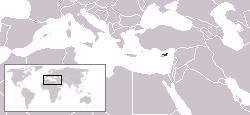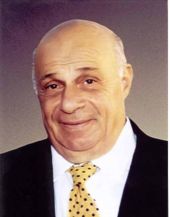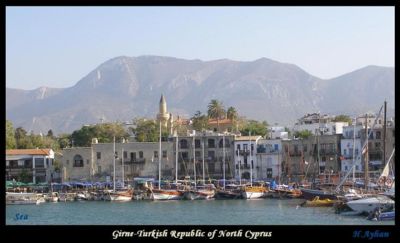Turkish Republic of Northern Cyprus
2007 Schools Wikipedia Selection. Related subjects: Countries; European Countries
| Kuzey Kıbrıs Türk Cumhuriyeti Turkish Republic of Northern Cyprus |
|||||
|
|||||
| Anthem: İstiklâl Marşı ( Turkish) "Independence March" |
|||||
| Capital | Nicosia (Lefkoşa) |
||||
|---|---|---|---|---|---|
| Official languages | Turkish | ||||
| Government | Representative democratic republic | ||||
| - President | Mehmet Ali Talat | ||||
| - Prime Minister | Ferdi Sabit Soyer | ||||
| Sovereignty | from Republic of Cyprus (de facto) | ||||
| - Proclaimed | November 15, 1983 | ||||
| - Recognition | Only by Turkey and OIC | ||||
| Area | |||||
| - Total | 3,355 km² ( not ranked) 1,295 sq mi |
||||
| - Water (%) | 2.7 | ||||
| Population | |||||
| - 2006 census | 264,172 | ||||
| - Density | 78/km² ( not ranked) 203/sq mi |
||||
| GDP ( PPP) | 2002 estimate | ||||
| - Total | $941.4 million ( not ranked) | ||||
| - Per capita | $4,409 ( not ranked) | ||||
| Currency | New Turkish Lira ( TRY) |
||||
| Time zone | EET ( UTC+2) | ||||
| - Summer ( DST) | EEST ( UTC+3) | ||||
| Internet TLD | .nc.tr | ||||
| Calling code | +90-392 | ||||
The Turkish Republic of Northern Cyprus (TRNC) ( Turkish: Kuzey Kıbrıs Türk Cumhuriyeti, KKTC) is a de facto formed state in northern Cyprus that is currently recognised only by Turkey. Indeed, the United Nations recognises the sovereignty of the Republic of Cyprus over the whole island.
Background
The TRNC was unilaterally established in 1983 nine years after a Greek Cypriot coup d'état. The short-lived coup was carried out by supporters of EOKA-B with backing from the ruling Greek military junta of 1967 to 1974. The ensuing Turkish invasion of Cyprus established this de facto political entity in Cyprus as a dependency of Turkey. The Turkish military maintain a strong presence in the TRNC to this day. Its immediate predecessor from 1975 to 1983 was the Turkish Federative State of North Cyprus; but the lead up to its establishment started in 1963 with the collapse of the Cypriot community into two antagonistic camps.
The TRNC has a population of about 265,000 and an area of 3,355 square kilometres (including the tiny enclave of Kokkina (Turkish: Erenköy). Its population is almost entirely Turkish-speaking ethnic Turks- although some Turkish Cypriots prefer emphasizing their Cypriot Turkishness, or simply their Cypriotness. The population consists of three main communities: indigenous Turkish Cypriots, integrated Turkish settlers who can be considered Turkish Cypriots either through marriage or birth on the island, and migrant Anatolian Turks; there are also some Kurds amongst the settlers . The Turkish Army is also present in the form of some 33,000 professional soldiers. Many of the older Turkish Cypriots speak and understand Greek - some may even be considered native speakers of the Greek Cypriot dialect. There are also populations of Greek Cypriots and Maronites still living in Dipkarpaz and Koruçam regions. The TRNC includes the northern part of the city of Nicosia (Turkish: Lefkoşa, Greek: Lefkosia), which serves as its capital. A large percentage of the people living in northern Cyprus after the 1963 have emigrated, particularly to United Kingdom but also to Turkey. Many left the island due to the grim economic situation of the TRNC which, because of the prevailing embargo imposed on it by the international community, faces many difficulties in trading with third countries. From the tip of the Karpass Peninsula ( Cape Apostolos Andreas) in the northeast, the TRNC extends westward to Morphou Bay and Cape Kormakitis (the Kokkina/Erenköy exclave marks the westernmost extent of the TRNC), and southward to the village of Louroujina/Akıncılar. The territory between the TRNC and the area under the control of the Republic of Cyprus is separated by a United Nations-controlled buffer zone.
History
1960 - Establishment of the Republic of Cyprus
The Republic of Cyprus was established after the British rejected Greek Cypriots' demands for its unification with Greece; they offered sovereignty instead and the island gained independence from the United Kingdom. Both the Greek Cypriot and Turkish Cypriot communities living on the island were called to govern the new republic. However, due to the clauses based in the Constitution of the Republic of Cyprus, no Turkish Cypriot could be elected President and no Greek Cypriot could be elected Vice President. Some international political analysts have stated that the constitution of the Republic of Cyprus was "a problem waiting to happen" (citation needed). Both communities were allocated seats in the governmental chambers and granted positions in the civil service. The Constitution provided that 70% of the members of the House of Representatives would be Greek Cypriots and 30% Turkish Cypriots. For some matters, such as the budget, separate majorities were required. For the army and the civil service, the ratio was set at 60-40 respectively. Greece, Turkey, and the UK became guarantor powers of the Republic under the 1960 Treaty of Guarantee.
UN Security Council Resolution 541 (1983) stated that the "attempt to create the Turkish Republic of Northern Cyprus is invalid, and will contribute to a worsening of the situation in Cyprus". It went on to state that it "considers the declaration referred to above as legally invalid and calls for its withdrawal".
1963 - Inter-communal fighting and constitutional collapse
In December 1963, the government of Cyprus collapsed after the Turkish Cypriots withdrew their participation. For 3 years its legislative powers were stalling due to the constant inability of the two communities to reach decisions. Tensions increased when Makarios proposed thirteen amendments to the constitution of the Republic of Cyprus.
Turkish Cypriots were opposed to the proposal since it allegedly re-classfied their status as a minority, instead of co-founders of the state; the proposals also removed what they saw as their community’s constitutional safeguards. These amendments were largely seen as a move towards Enosis (union with Greece) by Turkish Cypriots. On 21 December 1963, clashes between Turkish Cypriots and Polycarpos Yorgadjis (the Interior Minister) plainclothes special constables left two Turkish Cypriots and one Greek Cypriot policeman dead . Although the ensuing violence led to attacks launched by both communities, Turkish Cypriots had born the brunt of the offensive, leading to 700 Turkish Cypriot hostages being taken and full scale attacks launched by Nicos Sampson against the Turkish Cypriot population .
The fighting left 191 Turkish and 133 Greek Cypriots dead and 209 Turks and 41 Greeks missing . Widespread looting of Turkish Cypriot villages led to twenty thousand refugees retreating into armed enclaves which remained for 11 years, relying on food and medical supplies from Turkey to survive. Though much of the initial withdrawal was in the wake of violence, it has been alleged that the Turkish Cypriots' own paramilitary group TMT exercised influence in preventing some Turkish Cypriots returning to their villages, thus leading to the segregation of the communities.
Enclaves
According to Brigadier Francis Henn1, former Chief of Staff, UN Force in Cyprus from 1972-1974, the Turkish Cypriots were "besieged" and "56,000 members of the community had been deprived [by the Greek Cypriots authorities] of their normal means of subsistence".
1974 - Greek and Turkish military actions
On 15 July 1974, the Greek military junta of 1967-1974 backed a Greek Cypriot military coup d'état in Cyprus. President Makarios was removed from office and Nikos Sampson, a former EOKA fighter and a member of the Parliament, took over the presidency. Turkey claimed that under the 1960 Treaty of Guarantee the coup was sufficient reason for military action and thus Turkey invaded Cyprus on 20 July 1974. Turkey's position was that such intervention was necessary to protect the Turkish Cypriot populace. The coup failed and Makarios returned to Cyprus. Turkish forces proceeded to take over about 37% of the island, causing a large numbers of Greek Cypriots to abandon their homes. Over 195,000 Greek Cypriots fled to the south of the island, while 50,000 Turkish Cypriots fled north. By the end of the invasion, thousands of Turkish Cypriots from the southern communities were missing, as were thousands of Greek Cypriots missing from northern communities, although it is known that small numbers Greek-Cypriots have continued to live with their Turkish neighbours.
1975 - From federation to independence
In 1975, the "Turkish Federated State of North Cyprus" was declared as a first step to international recognition of a Turkish Cypriot separatist state in Cyprus. The move was rejected by the Republic of Cyprus, by the UN, and by the international community. After eight years of failed negotiations with the leadership of the Greek Cypriot Community, the north declared its independence on 15 November 1983 under the name of the Turkish Republic of Northern Cyprus. The UDI of the TRNC was rejected by the UN and the Republic of Cyprus.
- History of Cyprus
- Cyprus under the Ottoman Empire
- Cyprus dispute
- Operation Atilla
Reference 1 Brigadier Francis Henn, A Business of Some Heat - the UN force in Cyprus before and during the 1974 Turkish invasion, Pen & Sword Books 2004.
Politics
Its electoral system has a president elected for a five year term. Its legislature is the Assembly of the Republic (Cumhuriyet Meclisi) which has 50 members elected by proportional representation from five electoral districts. In the elections of February 2005, the Republican Turkish Party, which favours a peace settlement and the reunification of Cyprus, retained its position as the largest parliamentary party, but failed to win an overall majority.
Economy
The economy of the Turkish Republic of Northern Cyprus is dominated by the services sector including the public sector, trade, tourism and education, with smaller agriculture and light manufacturing sectors. The economy operates on a free-market basis, although it continues to be handicapped by the political isolation of Turkish Cypriots, the lack of private and governmental investment, high freight costs, and shortages of skilled labor. Despite these constraints, the Turkish Cypriot economy turned in an impressive performance in 2003 and 2004, with growth rates of 9.6% and 11.4%. This growth has been buoyed by the relative stability of the Turkish Lira and by a boom in the education and construction sectors. The Turkish Cypriots are heavily dependent on monetary transfers from the Turkish government. Under the 2003-06 economic protocol, Ankara plans to provide around $550 million to the TRNC. The number of tourists visiting Turkish Republic of Northern Cyprus during January-August 2003 was 286,901.
Over the same period, per capita income almost doubled
- US$4,409 (2002)
- US$5,949 (2003)
- US$8,095 (2004)
- US$10,248 (2005)
International status and foreign relations
The international community - with the exception of Turkey - does not recognize the TRNC as a sovereign state, but recognsie the de jure sovereignty of the Republic of Cyprus over the whole island. The United Nations considers the TRNC to be illegal in several of its resolutions. (Note: the Nakhichevan Autonomous Republic, an exclave of Azerbaijan, does regard the TRNC as sovereign, while the state of Azerbaijan officially has not followed suit). The Organization of the Islamic Conference gives the TRNC the status of a constituent state, and it is an observer member of this organization. A number of other nations have expressed gestures towards recognition including Pakistan, Qatar, and Gambia
Since the April 2004 referendum on the United Nations Annan Plan, the attitude of the international community towards the TRNC has begun to improve. Günter Verheugen, the EU's Enlargement Commissioner, was reported as saying that the EU was considering opening a representative office in the TRNC. EU foreign ministers agreed to give the TRNC 259 million euros (US$307 million) in aid. This aid was blocked by the Greek Cypriot Administration who argued that the Turkish Cypriots wanted to receive this money directly. That is why the southern Republic of Cyprus has blocked it at EU level. The result was for half of the money so far to be lost. A number of high profile formal meetings have also taken place between President Mehmet Ali Talat and various foreign leaders and politicians including US Secretary of State Condoleeza Rice, British foreign minister Jack Straw, Pakistani President Pervez Musharraf.
Legally, however, the European Union continues to consider Turkish Republic of Northern Cyprus as EU territory with a disputed foreign military presence and thus indefinitely exempt from EU legislation until a settlement has been reached. While certain outlying regions of the EU can and do obtain exemptions from EU law, Turkish Republic of Northern Cyprus is the only part of the Union where such laws are not enforceable. The number of seats assigned to Cyprus in the European Parliament (six seats) is based on the population of the entire island. Despite the fact that the Turkish Cypriot residents of Turkish Republic of Northern Cyprus- and possibly some of the naturalized Anatolian Turks - are EU citizens, fewer than expected Northerners voted in the 2004 elections. There is no support for admitting two Cypriot member states into the EU, as long as the Cyprus problem is not solved.
Military
The Turkish Republic of Northern Cyprus has a 2,000 man Defense Force which is primarily made up of conscripted Turkish Cypriot males between the ages of 18 and 40. This force supplements the 40,000 strong Turkish Army force, which includes the XI Corps with two divisions, which is stationed on the island.
As an area under dispute, the Turkish military presence in Turkish Republic of Northern Cyprus is seen differently by the communities in the region, the Greek population seeing it as an occupational force, while the Turkish Republic of Northern Cyprus citizens see it as protecting their life.
Communications and transport
Because of its status, the TRNC is heavily dependent on Turkish military and economic support. It uses the New Turkish Lira as its currency. All TRNC exports and imports have to take place via Turkey. International telephone calls are routed via a Turkish dialling code: +90 392. On the web TRNC is under the Turkish second-level domain .nc.tr, and mail must be addressed via Mersin 10, TURKEY as the Universal Postal Union refuses to recognize the TRNC as a separate entity.
Direct flights to Turkish Republic of Northern Cyprus are forbidden by the Republic of Cyprus. The airports of Geçitkale and Ercan are only recognized as legal ports of entry by Turkey and Azerbaijan.
TRNC sea ports had been declared closed to all shipping by the Republic of Cyprus since 1974. Turkey, however, rejects this declaration while TRNC-registered vessels have free access to Turkish sea ports.
Naturalized TRNC citizens or foreigners carrying a passport stamped by the TRNC authorities may be refused entry by the Republic of Cyprus or Greece, although after the accession of the Republic of Cyprus to the EU such restrictions have been eased following confidence-building measures between Athens and Ankara and the partial opening of the UN controlled line by the Turkish Republic of Northern Cyprus authorities. The Republic of Cyprus also allows passage across the Green Line from the part of Nicosia that it controls (as well as a few other selected crossing points), since the TRNC does not leave entry stamps in the passport for such visits.
Airports and harbours
- Ercan/Tymvou Airport (Lefkoşa/Nicosia - Main Airport)
- Geçitkale/Lefkoniko Airport (Gazimağusa/Famagusta)
- Ilker Karter Airport (Girne/Kyrenia)
- Pınarbaşı Airport (Girne/Kyrenia)
- Topel Airport (Güzelyurt/Morphou)
- Port of Girne/Kyrenia
- Port of Gazimağusa/Famagusta
Universities
- Eastern Mediterranean University
- Near East University
- European University of Lefke
- International Cyprus University
- Girne American University
- Middle East Technical University Northern Cyprus Campus / Guzelyurt
NGOs
- Management Centre for the Eastern Mediterranean
The Management Centre for the Eastern Mediterranean is an umbrella and support institution for civil society organisations in Turkish Republic of Northern Cyprus. It organises conferences, training and other events, contains useful lists of NGOs and other organisations and reports from studies and initiatives.
- Turkish Republic of Northern Cyprus Red Crescent Association
Turkish Republic of Northern Cyprus Red Crescent Association Crescent claims descent from an organisation founded in 1974, but was long dormant. It started to try and reorganise itself in 2005.
In April 2006, a General Assembly of the organisation elected the recently retired president of the supreme court, Taner Erginel, as President.
Tourist attractions
- Lefkoşa has an old town centre similar to that of Gazimağusa. The ancient city centre is surrounded by a 5.5 km long city wall, which is still intact.
- To the northeast the mythical Five Finger mountains ( Pentadactylos, Turkish: Beşparmak) guard the city. This rocky five finger mountain rises 700 meters above sea level and harbours the legend of the Byzantine hero Digenis, who defeated the invading Arabs with supernatural strength.
- A giant TRNC flag is painted on the southern side of the mountain, near the village of Vouno/Taşkent, which can be easily seen from most of Lefkoşa.
- One of the most beautiful beaches in the Mediterranean is in the Karpaz in the furthest Easten tip of the island and is a nesting ground for endangered loggerhead and green turtles.






